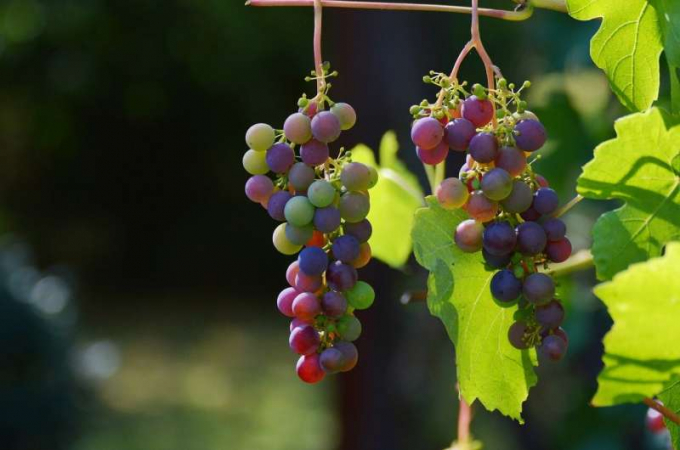November 28, 2025 | 02:51 GMT +7
November 28, 2025 | 02:51 GMT +7
Hotline: 0913.378.918
November 28, 2025 | 02:51 GMT +7
Hotline: 0913.378.918

A high yielding grape. Photo: Getty
And since the domestication of the grapevine 8,000 years ago, breeding has continued to be a gamble.
When today's growers cultivate new varieties—trying to produce better-tasting and more disease-resistant grapes —it takes two to four years for breeders to learn whether they have the genetic ingredients for the perfect flower.
Females set fruit, but produce sterile pollen. Males have stamens for pollen, but lack fruit. The perfect flower, however, carries both sex genes and can self-pollinate. These hermaphroditic varieties generally yield bigger and better-tasting berry clusters, and they're the ones researchers use for additional cross-breeding.
Now, Cornell University scientists have worked with the University of California, Davis, to identify the DNA markers that determine grape flower sex. In the process, they also pinpointed the genetic origins of the perfect flower. Their paper, "Multiple Independent Recombinations Led to Hermaphroditism in Grapevine," published April 13 in the Proceedings of the National Academy of Science.
"This is the first genomic evidence that grapevine flower sex has multiple independent origins," said Jason Londo, corresponding author on the paper and a research geneticist in the USDA-Agricultural Research Service (USDA-ARS) Grape Genetics Unit, located at Cornell AgriTech. Londo is also an adjunct associate professor of horticulture in the School of Integrative Plant Science (SIPS), part of the College of Agriculture and Life Sciences.
"This study is important to breeding and production because we designed genetic markers to tell you what exact flower sex signature every vine has," Londo said, "so breeders can choose to keep only the combinations they want for the future."
Today, most cultivated grapevines are hermaphroditic, whereas all wild members of the Vitis genus have only male or female flowers. As breeders try to incorporate disease-resistance genes from wild species into new breeding lines, the ability to screen seedlings for flower sex has become increasingly important. And since grape sex can't be determined from seeds alone, breeders spend a lot of time and resources raising vines, only to discard them several years down the line upon learning they're single-sex varieties.
In the study, the team examined the DNA sequences of hundreds of wild and domesticated grapevine genomes to identify the unique sex-determining regions for male, female and hermaphroditic species. They traced the existing hermaphroditic DNA back to two separate recombination events, occurring somewhere between 6 million and 8,000 years ago.
Londo theorizes that ancient viticulturists stumbled upon these high yielding vines and collected seeds or cuttings for their own needs—freezing the hermaphroditic flower trait in domesticated grapevines that are used today.
Many wine grapes can be traced back to either the first or second event gene pool. Cultivars such as cabernet franc, cabernet sauvignon, merlot and Thompson seedless are all from the first gene pool. The pinot family, sauvignon blanc and gamay noir originate from the second gene pool.
What makes chardonnay and riesling unique is that they carry genes from both events. Londo said this indicates that ancient viticulturalists crossed grapes between the two gene pools, which created some of today's most important cultivars.
Documenting the genetic markers for identifying male, female and perfect flower types will ultimately help speed cultivar development and reduce the costs of breeding programs.
"The more grape DNA markers are identified, the more breeders can advance the wine and grape industry," said Bruce Reisch, co-author and professor in both the Horticulture and the Plant Breeding and Genetics sections of SIPS. "Modern genetic sequencing technologies and multi-institutional research collaborations are key to making better grapes available to growers."
(Cornell University)

(VAN) A new study reveals how the simultaneous effects of ocean acidification, salinity and loss of oxygen are making the world more fragile.

(VAN) Hopes are growing that the creation of the first 3D turkey gut model could be a turning point in the battle against the virulent blackhead disease.

(VAN) Tyson, America’s biggest meat supplier, plans to shutter one of its largest beef processing plants as the industry continues to struggle with low cattle supplies and political pressure from Washington.

(VAN) New FAO study shows how digital solutions are empowering farmers and fishers to prevent losses and build resilient agrifood systems.

(VAN) Brazil's COP30 presidency pushed through a compromise climate deal on Saturday that would boost finance for poor nations coping with global warming but that omitted any mention of the fossil fuels driving it.

(VAN) Poultry farmers in the UK have been warned that they could face one of the worst winters yet for bird flu.

(VAN) Prices of main-crop paddy have risen sharply, with jasmine rice hitting 16,100 baht per tonne — the highest level in years.